
As wonderful as fish are, some people are looking for something a bit different. Crabs offer a completely different aesthetic, and one of the most attractive is the Panther Crab.
These freshwater species have a distinctive design to leave you captivated.
They are easy to keep as well, which makes them a tempting option for beginners. You do need to be careful around their aggression though, which makes designing the right tank particularly important.
This article will cover everything about Panther Crab care, including how to deal with their territorial nature.
They aren’t as commonly kept as other freshwater crabs, so hopefully, this article helps you to realize that they are the species for you.
TABLE OF CONTENTS
Panther Crab Facts & Overview
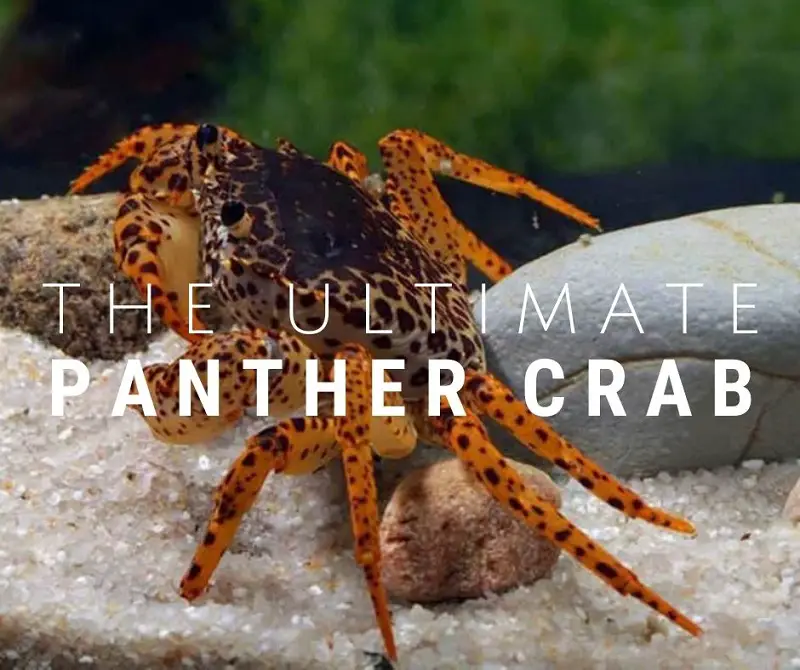
| Category | Rating |
| Care Level: | Easy |
| Temperament: | Territorial |
| Color: | Orange with dark spots |
| Lifespan: | Up to 10 years |
| Size: | Up to 5 inches |
| Diet: | Omnivore |
| Family: | Gecarcinucidae |
| Minimum Tank Size: | 20 gallons |
| Tank Set-Up: | Freshwater with rocks and caves |
| Compatibility: | Species tank |
The Panther Crab is a freshwater crustacean from the Gecarcinucidae family. They are one of many crabs that can be kept in home aquariums, but they are quite an uncommon sight though, despite being a beautiful option.
This is even more surprising considering that they are not too difficult to care for. With a little research, most people would be able to successfully keep some, even beginners.
One explanation might be their endangered status. Due to nickel mining on lakeshores (where they live), natural populations are at risk because of habitat damage and poor water conditions. Breeding them in captivity can be difficult too.
They are only found on an Indonesian island called Sulawesi, with the largest populations living in Lake Matano.
You might see Panther Crabs being sold under a couple of different names, such as Leopard Crabs or Parathelphusa pantherine, which is their scientific name.
You may have to look around for a while to find a local stock of this species because of their rarity. Try checking online before heading to a pet store, or call ahead.
Individual fish tend to cost between $10 and $20. In areas where stocks are particularly scarce, prices could be pushed up further.
If cared for properly, Panther Crabs can survive for up to 10 years in captivity. They are a long-term commitment, so be prepared for this before buying any.
Typical Behavior
The first thing to note is that Panther Crabs are nocturnal, meaning that they are most active at night. This is when they will do most of their scavenging for food, though they may learn your specific feeding routine over time.
A behavioral trait of all crustaceans is molting. This is a process where a crustacean sheds an old exoskeleton to develop a larger one, which will fit a growing body.
It takes a couple of days for the new exoskeleton to harden. During this time, they are very vulnerable because they don’t have a hard casing to protect them from physical damage.
To keep themselves safe, your crabs will hide away until the molting process is over. Leave them alone while they molt to avoid injury.
Remove the discarded exoskeleton. If left, it will be broken down and alter the water chemistry.
Panther Crabs are territorial by nature, so they need a large area of the tank that they can claim for themselves.
This is usually only a problem if you plan to keep multiple crabs since these are likely to fight if they enter each other’s territories.
Appearance
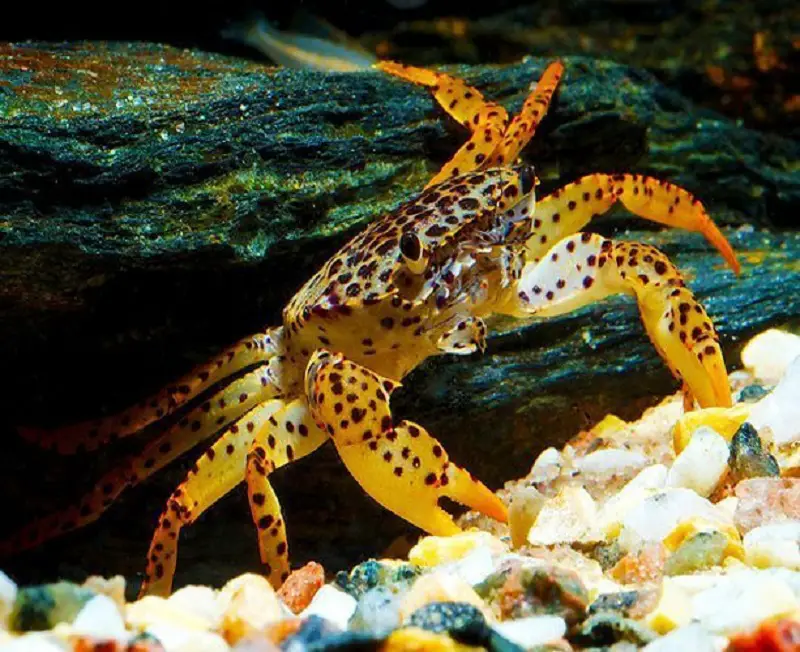
This species has a striking appearance. They are truly attractive creatures that give even the most beautiful fish a run for their money. Once you see them, it is difficult to resist purchasing some.
Their common names give away what they look like. Their whole body (including their legs and claws) are covered in small brown spots, just like a Panther or a Leopard.
An individual’s color can vary between shades of yellow, orange, or brown, but the colors are typically darker on the legs and paler on the carapace.
However, the carapace often has a greater density of larger spots, which can make it appear dark.
Sometimes the limbs will be red-tipped, but only a few populations have this trait.
They have 10 legs (including the claws), which means they are classed as a Decapod. The term can be literally translated from Greek to mean “ten-foot” (deca-pod).
Their eyes are held up on stalks to give them a broad field of view. Next to the eyes are antennae while acting as sensory organs for touch, taste, and smell.
Compared to other freshwater crabs, Panther Crabs are quite larger. Their carapace alone reaches 3 inches, so they can span much further (at least 5 inches) when they stretch their legs out.
To determine if a crab is male or female, you will need to carefully look at their underside. Males have a thin flap on their belly, but females have a bigger and rounder one.
Males also have a narrower abdomen plate compared to females.
Habitat and Tank Conditions
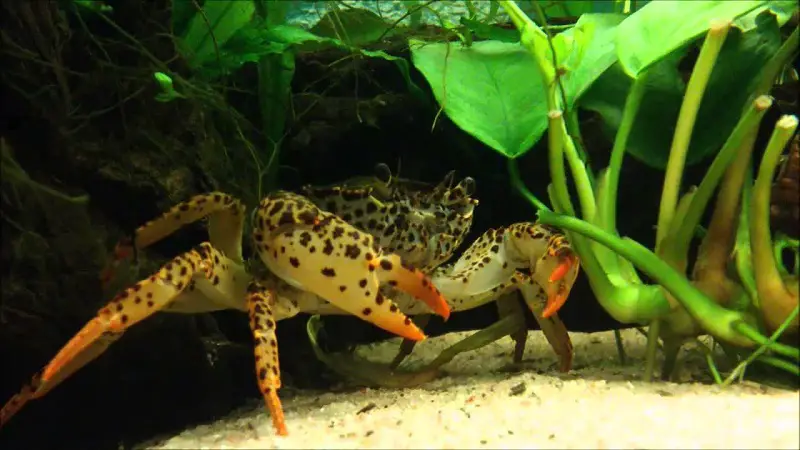
As we mentioned earlier, natural populations of Panther Crabs are only found on the island of Sulawesi in Indonesia.
Such a narrow geographic range indicates that conditions in Sulawesi are perfect for this species to thrive. You must replicate these conditions as closely as you can to keep your crabs healthy.
The largest populations live in Lake Matano, so this is the best place to model.
The tropical water here boasts warm temperatures. It would also be slightly acidic. There would be little water movement and plenty of access to sunlight.
The floor of the lake would be sandy but covered in debris such as rocks and wood. Panther Crabs would claim the caves that the debris creates as their territory.
Occasionally a crab might venture out onto the shore, but they are happy living a fully aquatic life too.
Tank Conditions
Some Panther Crab aquariums will look very different to others, it depends on whether you want to provide an area of land for them to climb out onto.
They are listed as a fully aquatic species, so it isn’t essential that they have an area of land in the tank. This leaves the decision up to you.
Under the water, layer the floor with a sandy substrate. The fine grains make it easy for your crabs to burrow, which is a natural behavior that they’ll display around their territory.
On top of the substrate, you can focus on creating a few caves. Panther Crabs will each claim one as a territory that they can retreat to when resting in the day or when stressed.
Caves are easy to make out of decorations and rocks.
You can add live plants if you want, but be warned that they might be damaged by your crabs. They are adept at uprooting and eating plants.
A way to get around this is to use floating plants (like Hornwort), to keep them out of reach. Otherwise, you can plant a tough species like Java Ferns in the substrate.
Controlling the water chemistry is crucial to an aquatic pet’s survival. Panther Crabs need a temperature of 77-86°F and a pH of 7.5-8.5.
The only pieces of equipment you’ll need are a filter and a heater. Standard aquarium lighting will be fine, and you don’t need an air/water pump because this species is used to slow-moving waters in a lake.
What Size Aquarium do they need?
When keeping just one Panther Crab, the minimum tank size is 20 gallons. This provides plenty of space for a large territory.
As one of the larger freshwater crab species, the more space you can offer, the better.
How Many Can be kept per gallon?
Ideally, Panther Crabs would be kept singly to avoid fighting, which is especially likely between males.
If you want to keep one male with multiple females, ensure that there is enough space for everyone to have a territory of about thirty inches.
Space out caves around the aquarium to make this possible.
Tank Mates
It is very difficult to house Panther Crabs with tank mates.
Other species of crab are generally unsuitable because fighting is virtually guaranteed, which will lead to casualties. Crayfish can lead to the same problems.
Shrimps are generally okay if they are speedy. Your Panther Crabs will eat them if they get the chance, but shrimps should be able to get away. Cardinal Shrimp (also from Lake Matano) are suitable.
Fish are best avoided since these crabs are opportunistic scavengers. Small weakfish could fall prey to a scavenging crab, and larger fish could damage a crab during a molt.
Panther Crabs are active at night when fish are resting and vulnerable.
The safest option is to keep them in a species tank.
Can You Keep Panther Crabs Together?
Panther Crabs are territorial and will fight with one another, especially males. For this reason, it is recommended that you only keep one fish in your tank.
If you’re insistent on keeping multiple crabs, ensure that there is only one male in the group and the rest are females. You will need a large aquarium so that every crab can claim a large territory (about 30 inches each).
Diet
These scavengers will eat anything they find as they roam the aquarium. They’re omnivores, so they will happily consume meaty foods and vegetation.
It is easy to supply a range of nutrients for omnivores since they can eat so many different foods with varying contents. Do your best to vary their diet to keep them as healthy as possible.
Dried foods are very convenient. Pellets, flakes, and algae wafers will be readily accepted. However, their nutritional content is low due to the manufacturing process, so supplement them with frozen/live foods.
Some good examples include brine shrimp and bloodworms.
To further mix up their diet, you can add in chopped up green vegetables from your kitchen. Zucchini, cucumber, and spinach will go down as a treat.
Remember that their love of vegetation will probably transfer over to any live plants you are keeping, so make sure you have hardy plant species that can survive repeated damage.
Calcium is an important component of a Panther Crab’s diet. They need it for growth and to develop a strong exoskeleton. Lancetfish and unshelled shrimp are a couple of foods containing plenty of calcium.
If you don’t think your crabs are getting enough calcium from their diet, you can use calcium supplements.
Feed them 3-5 times a week, they’ll eat algae and detritus in between feeding times.
Care
Once you have the aquarium set up and running, caring for Panther Crabs is relatively easy. They will stay healthy if they are being fed properly and their environment is kept in their preferred conditions.
This involves physically cleaning the tank, by wiping away excess algae and maintaining the water chemistry. Regular water changes help with this. The less water you have, the more frequent they should be.
Your tank should have a tight-fitting lid on because this species has been known to climb; you don’t want to find they’ve disappeared one morning.
Even though very small amounts are needed, copper is largely toxic to crustaceans; any increase in concentration could lead to deaths. Check the labels on anything that you’re adding into the water, such as foods and medications.
Be careful while a Panther Crab is molting because they are prone to injury without an exoskeleton. Leave them alone and try not to touch them until their new casing has fully developed.
Remove the old exoskeleton once it has been discarded. If you leave it in the water, it will be broken down over time which could raise nitrate levels in the water.
Diseases are uncommon, but they can be introduced to the tank when you add new creatures or equipment. Pathogens thrive in poor water conditions, so keep the tank clean!
Bacteria and parasites cause the most problems. There are treatments available in stores to treat most of these. Quarantine the infected crab until the treatment is over.
Breeding
Panther Crabs can be bred in captivity, but their territorial nature might sometimes make it difficult.
Just ensure that the tank is clean, you have at least one male and one female, and you’re feeding them a nutritious diet. It isn’t much else you can do, hopefully, the mating process will initiate itself.
When ready to mate, the female will release pheromones to attract a male. If there are multiple males in the tank, the female could get hurt, so only keep one male.
The male will fertilize the female’s eggs, which she will then lay. They might be placed in a cave or be burrowed slightly in the substrate where they are protected.
Separate the adults from the young once they have hatched, to prevent any getting eaten.
Are Panther Crabs Suitable for Your Aquarium?
Hopefully, this guide has persuaded you to get a Panther Crab since they aren’t kept by aquarists as much as they deserve.
Unfortunately, their aggression can limit potential tank mates. But even a tank containing just one Panther Crab is a very interesting addition.
Their ease of care is a selling point to aquarists of all experience levels. Intervention from you mainly involves feeding and cleaning the tank, which doesn’t take up much time.
Anyone looking for freshwater crabs will be very happy with a Panther Crab; they are beautiful animals that display plenty of character.
What is your favorite species of a freshwater crab? Let us know in the comments below…


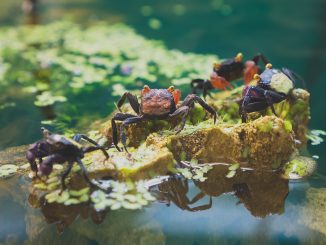
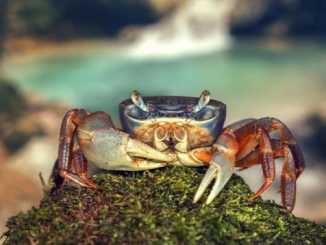
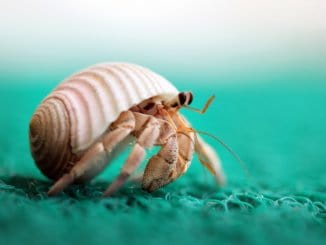

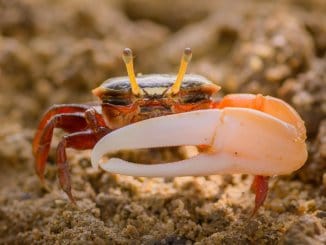
Be the first to comment